Tifinagh
Tifinagh (Tuareg Berber language: ⵜⴼⵏⵗ or ⵜⴼⵉⵏⵗ, Berber pronunciation: [tifinaɣ]) is an abjad script used to write the Berber languages. Tifinagh is descended from the ancient Libyco-Berber alphabet.[1] The traditional Tifinagh, sometimes called Tuareg Tifinagh, is still favored by the Tuareg Berbers of the Sahara desert in southern Algeria, northeastern Mali, northern Niger and northern Burkina Faso for use writing the Tuareg Berber language. Neo-Tifinagh (ⵜⵉⴼⵉⵏⴰⵖ) is an alphabet that was created in northern Algeria around the 1980s as an updated version.[2] Neo-Tifinagh has been used since largely by Algerians and Moroccans for the symbolic promotion of the Berber language, while mainly using the Berber Latin alphabet in most publications. Neo-Tifinagh is often simply called "Tifinagh".
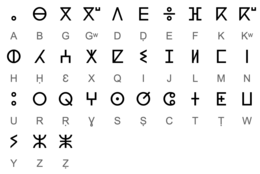
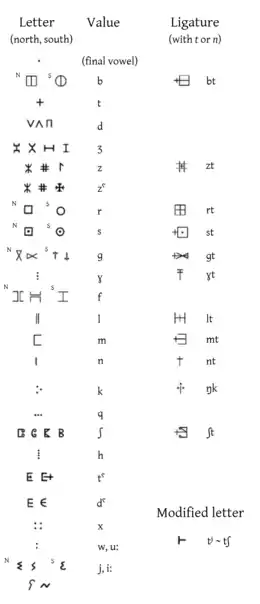
The script has evolved over time. The early forms of the Libyco-Berber script loosely date from around the 2nd century BCE; traditional Tifinagh seems to have formed in the 1st millenium at some point; and Neo-Tifinagh dates to the 1980s. There are significant differences between the ancient Libyco-Berber script and the Tuareg Tifinagh script. Many letters from the ancient Libyco-Berber script do not exist (anymore) in the Tuareg Tifinagh, while other letters evolved into a different pronunciation in the current Tuareg Tifinagh script. There are also significant differences between the classic script and the more modern Neo-Tifinagh alphabet. Many Tuareg Tifinagh letters are discarded in Neo-Tifinagh, and other ones are modified in form or in pronunciation. The Neo-Tifinagh alphabet also features invented vowels and other letters not found in Tuareg Tifinagh. About half of the letters in the Neo-Tifinagh alphabet were either completely invented (ⵥ,ⴻ,ⵕ,ⵄ,ⵃ,ⵞ,ⵯ,ⵇ,ⵚ,ⴽ,ⵅ,ⴿ,ⵖ,ⵠ), modified in form (ⴰ,ⵓ,ⴼ,ⵁ,ⵍ) or repurposed for a different pronunciation (ⵀ,ⵡ,ⴵ). All traditional Tuareg Tifinagh letters that consist entirely of dots (ⵗ,ⵈ,ⴾ,ⵆ,ⵘ,ⵂ) were discarded by the creators of Neo-Tifinagh and were replaced by newly invented ones. Tuareg people in the Sahara desert continue to use these dotted letters as part of their traditional script, thus deliberately distinguishing their writings from the northern Berbers of Morocco and northern Algeria who use the Neo-Tifinagh alphabet or the Berber Latin alphabet in writing the Berber language.
The ancient Libyco-Berber script[3][4] (or the Libyc script) was used by the ancient northern Berbers known as Libyco-Berbers,[5][6] also known as Libyc people, Numidians, Afri and Mauretanians who inhabited the northern parts of Morocco, Algeria, Tunisia and Libya as well as the Canary Islands west of Morocco.
The name Tifinagh is stylized as Tifinaɣ in the Berber Latin alphabet, and in the Neo-Tifinagh alphabet it is written as ⵜⵉⴼⵉⵏⴰⵖ, while in the Tuareg people's traditional Tifinagh it's written as ⵜⴼⵉⵏⵗ or ⵜⴼⵏⵗ.
Etymology
The word tifinagh (singular tafinəq < *ta-finəɣ-t) is thought by some scholars to be a Berberized feminine plural cognate or adaptation of the Latin word "Punicus", (meaning "Punic" or "Phoenician") through the Berber feminine prefix ti- and the root √FNƔ < *√PNQ < Latin Punicus; thus tifinagh could possibly mean "the Phoenician (letters)"[7][8][9] or "the Punic letters". Others support an etymology involving the Tuareg verb efnegh, meaning to write.[10] However, the Tuareg verb efnegh is probably derived from the noun "Tifinagh" because all the northern Berbers of Morocco, northern Algeria, Tunisia and northern Libya have a different (and probably older) verb "ari, aru, ara" which means "to write".
Libyco-Berber
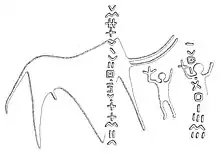
Before or during the existence of the ancient Berber kingdoms of Numidia (northern Algeria) and Mauretania (northern Morocco) many inscriptions were engraved using the Libyco-Berber script, also known as Ancient Libyan or the Libyc script (libyque). The Libyco-Berber script is found in thousands of stone inscriptions and engravings throughout Morocco, northern Algeria, Tunisia, northern Libya and the Canary Islands.
The traditional Tuareg Tifinagh and Saharan Tifinagh inscriptions and rock paintings are found in the Sahara deserts of southern Algeria, northern Mali and northern Niger. Thus, the Libyco-Berber script is a northern script, while Tifinagh is a southern / Saharan script.
The exact evolution of both Libyco-Berber and Tifinagh is still unclear.[11] The latter writing system was widely used in antiquity by speakers of the largely undeciphered Numidian language, also called Old Libyan, throughout Africa and on the Canary Islands. The script's origin is uncertain, with some scholars suggesting it is related to, descended or developed from the Phoenician alphabet,[12] while others arguing an independent conception with slight Phoenician influences.[13] Its first appearance is also uncertain, but it is no older than the first millennium BCE,[14] with the oldest remains likely originating from the 6th-century BCE.[15] It disappeared in the northernmost areas of North Africa during the 8th-century, after the Arab conquest of the Maghreb, and Lybico-Berber along with Latin being replaced by the Arabic script.[16]
There are two known variants of the Libyco-Berber script: eastern and western. The eastern variant was used in what is now Constantine and the Aurès regions of Algeria and in Tunisia. It is the best-deciphered variant, due to the discovery of several Numidian bilingual inscriptions in Libyco-Berber and Punic (notably at Dougga in Tunisia). Since 1843, 22 letters out of the 24 have been deciphered. The western variant was more primitive. It was used along the Mediterranean coast from Kabylia to the Canary Islands. It used 13 supplementary letters.
The Libyco-Berber script was a pure abjad; it had no vowels. Gemination was not marked. The writing was usually from the bottom to the top, although right-to-left, and even other orders, were also found. The letters took different forms when written vertically than when they were written horizontally.[17]
Tuareg Tifinagh
| Tifinagh | |
|---|---|
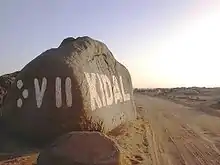 Entrance to the town of Kidal. The name is written in Tuareg Tifinagh (ⴾⴸⵍ/ Kdl) and Latin script. | |
| Script type | |
Time period | Unknown to today |
| Direction | left-to-right |
| Languages | Tuareg Berber language |
| Related scripts | |
Parent systems | ? Egyptian hieroglyphs
|
Child systems | Neo-Tifinagh (20th century) |
The ancient Libyco-Berber script branched into the Tuareg Tifinagh script which is used to this day to write the Berber Tuareg languages, which belong to the Berber branch of the Afroasiatic family. Early uses of the script have been found on rock art and in various sepulchres. Among these are the 1,500 year old monumental tomb of the Tuareg matriarch Tin Hinan, where vestiges of a Tifinagh inscription have been found on one of its walls.[19]
According to M.C.A. MacDonald, the Tuareg are "an entirely oral society in which memory and oral communication perform all the functions which reading and writing have in a literate society ... The Tifinagh are used primarily for games and puzzles, short graffiti and brief messages."[11]
Occasionally, the script has been used to write other neighbouring languages such as Tagdal, which belongs to a separate Songhay family.
Orthography
Common forms of the letters are illustrated at left, including various ligatures of t and n. Gemination, though phonemic, is not indicated in Tifinagh. The letter t, +, is often combined with a preceding letter to form a ligature. Most of the letters have more than one common form, including mirror-images of the forms shown here.
When the letters l and n are adjacent to themselves or to each other, the second is offset, either by inclining, lowering, raising, or shortening it. For example, since the letter l is a double line, ||, and n a single line, |, the sequence nn may be written |/ to differentiate it from l. Similarly, ln is ||/, nl |//, ll ||//, nnn |/|, etc.
Traditionally, the Tifinagh script does not indicate vowels except word-finally, where a single dot stands for any vowel. In some areas, Arabic vowel diacritics are combined with Tifinagh letters to transcribe vowels, or y, w may be used for long ī and ū.
Neo-Tifinagh
| Neo-Tifinagh | |
|---|---|
 | |
| Script type | |
Time period | 1970 to present |
| Direction | left-to-right |
| Languages | Standard Moroccan Berber and other Northern Berber languages |
| Related scripts | |
Parent systems | ? Egyptian hieroglyphs
|
| ISO 15924 | |
| ISO 15924 | Tfng (120), Tifinagh (Berber) |
| Unicode | |
Unicode alias | Tifinagh |
Unicode range | U+2D30–U+2D7F |
Neo-Tifinagh is the modern fully alphabetic script developed in northern Algeria from the traditional Tifinagh. Neo-Tifinagh is written left to right. Neo-Tifinagh was created in northern Algeria during the 1980s. Neo-Tifinagh spread from Algeria to Morocco and was rebranded by the Moroccan Royal Institute of the Amazigh Culture (IRCAM) as "Tifinaghe-Ircam" or simply "Tifinaghe", and is used in a small part of Moroccan and some Libyan elementary schools to teach the Berber language to children, as well as in a number of literary publications and some websites and media.[21][22] In Algeria, most Berber language education programs in elementary schools, high schools and university use the Berber Latin alphabet, while a small number of schools use Neo-Tifinagh, Tuareg Tifinagh in the south, or even the Arabic alphabet.
Until recently, virtually no books or websites were published in the Neo-Tifinagh alphabet, with activists favouring the Latin (or, more rarely, Arabic) scripts for serious use; however, Neo-Tifinagh is popular for symbolic use in Morocco and northern Algeria, with many books and websites written in a different script featuring logos or title pages using Neo-Tifinagh.
In Morocco, the king took a "neutral" position between the claims of Latin script and Arabic script by adopting Neo-Tifinagh in 2003; as a result, books and websites are beginning to be published in this script (for instance, the Berber version of the Moroccan Department of Education website is written in Tifinagh), and it is taught in some schools. However, many independent Berber-language publications are still published using the Berber Latin alphabet. Outside Morocco, it has no official status. The Moroccan state arrested and imprisoned people using this script during the 1980s and 1990s.[23] The Algerian Black Spring was also partly caused by this repression of Berber language.[24]
In Algeria, almost all Berber publications use the Berber Latin Alphabet.
In Libya, the government of Muammar Gaddafi consistently banned Tifinagh from being used in public contexts such as store displays and banners.[25]
After the Libyan Civil War, the National Transitional Council has shown an openness towards the Berber language. The rebel Libya TV, based in Qatar, has included the Berber language and the Neo-Tifinagh alphabet in some of its programming.[26]
Letters
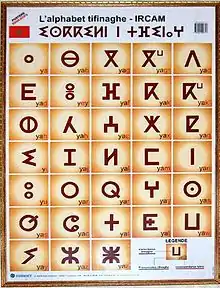
The following are the letters and a few ligatures of traditional Tuareg Tifinagh and Neo-Tifinagh:[27]
|
| |||||||||||||||||||||||||||||||||||||||||||||||||||||||||||||||||||||||||||||||||||||||||||||||||||||||||||||||||||||||||||||||||||||||||||||||||||||||||||||||||||||||||||||||||||||||||||||||||||||||||||||||||||||||||||||||||||||||||||||||||||||||||||||||||||||||||||||||||||||||||||||||||||||||||||||||||||||||||||||||||||||||||||||||||||||||||||||||||||||||||||||||||||||||||||||||||||||||||||||||||||||||||||||||||||
|
| ||||||||||||||||||||||||||||||||||||||||||||||||
| Basic Tifinagh (IRCAM)[28] | Extended Tifinagh (IRCAM)[27] | Other Tifinagh letters | Modern Tuareg letters |
Unicode
Tifinagh was added to the Unicode Standard in March 2005, with the release of version 4.1.
The Unicode block range for Tifinagh is U+2D30–U+2D7F:
| Tifinagh[1][2] Official Unicode Consortium code chart (PDF) | ||||||||||||||||
| 0 | 1 | 2 | 3 | 4 | 5 | 6 | 7 | 8 | 9 | A | B | C | D | E | F | |
| U+2D3x | ⴰ | ⴱ | ⴲ | ⴳ | ⴴ | ⴵ | ⴶ | ⴷ | ⴸ | ⴹ | ⴺ | ⴻ | ⴼ | ⴽ | ⴾ | ⴿ |
| U+2D4x | ⵀ | ⵁ | ⵂ | ⵃ | ⵄ | ⵅ | ⵆ | ⵇ | ⵈ | ⵉ | ⵊ | ⵋ | ⵌ | ⵍ | ⵎ | ⵏ |
| U+2D5x | ⵐ | ⵑ | ⵒ | ⵓ | ⵔ | ⵕ | ⵖ | ⵗ | ⵘ | ⵙ | ⵚ | ⵛ | ⵜ | ⵝ | ⵞ | ⵟ |
| U+2D6x | ⵠ | ⵡ | ⵢ | ⵣ | ⵤ | ⵥ | ⵦ | ⵧ | ⵯ | |||||||
| U+2D7x | ⵰ | ⵿ | ||||||||||||||
| Notes | ||||||||||||||||
References
- LBI LIBYCO-BERBER INSCRIPTIONS ONLINE DATABASE
- Evolution of the Tifinagh script in Unicode
- Libyco-Berber - 2nd (9th?) century BC-7th century AD
- Written in stone: the Libyco-Berber scripts
- Libyco-Berber relations with ancient Egypt: the Tehenu in Egyptian records
- History of Humanity: From the seventh to the sixteenth century. Edited by Sigfried J. de Laet
- L'ECRITURE LIBYCO-BERBERE: Etat des lieux et perspectives
- Penchoen (1973:3)
- O'Connor (2006:115)
- D. Vance Smith. "Africa's ancient scripts counter European ideas of literacy". Aeon. Retrieved 2021-06-24.
- M.C.A. MacDonald (2005). Elizabeth A. Slater, C.B. Mee and Piotr Bienkowski (ed.). Writing and Ancient Near East Society: Essays in Honor of Alan Millard. T.& T.Clark Ltd. p. 60. ISBN 9780567026910.
- L'ECRITURE LIBYCO-BERBERE: Etat des lieux et perspectives
- Suleiman, Yasir (1996). Language and Identity in the Middle East and North Africa. Psychology Press. p. 173. ISBN 978-0-7007-0410-1.
- Papers of the Peabody Museum of American Archaeology and Ethnology, Harvard University, p. 129
- Written Culture in a Colonial Context: Africa and the Americas 1500 - 1900, p. 11
- Landscapes, Sources and Intellectual Projects of the West African Past: Essays in Honour of Paulo Fernando de Moraes Farias, p. 185
- "Berber". Ancient Scripts. Archived from the original on 2017-08-26. Retrieved 2017-10-09.
- L'ECRITURE LIBYCO-BERBERE: Etat des lieux et perspectives
- Briggs, L. Cabot (February 1957). "A Review of the Physical Anthropology of the Sahara and Its Prehistoric Implications". Man. 56: 20–23. doi:10.2307/2793877. JSTOR 2793877.
- L'ECRITURE LIBYCO-BERBERE: Etat des lieux et perspectives
- "Institut Royal de la Culture Amazighe" (in French). Ircam.ma. Archived from the original on April 25, 2008. Retrieved 2015-07-14.
- "Institut Royal de la Culture Amazighe". Ircam.ma. Archived from the original on April 21, 2008. Retrieved 2015-07-14.
- "Rapport sur le calvaire de l'écriture en Tifinagh au Maroc". Amazighworld.org. Retrieved 2017-10-09.
- "Algérie: 10 ans après son « printemps noir », la Kabylie réclame justice – Jeune Afrique". JeuneAfrique.com (in French). 2011-04-20. Retrieved 2021-05-08.
- سلطات الامن الليبية تمنع نشر الملصق الرسمي لمهرجان الزي التقليدي بكباو [Libyan security authorities to prevent the publication of the official poster for the festival traditional costume Pkpau] (in Arabic). TAWALT. 2007.
- "Libya TV – News in Berber". Blip.tv. Retrieved 2015-07-14.
- P. Andries, Proposition d'ajout de l'écriture tifinaghe. Organisation internationale de normalisation, Jeu universel des caractères codés sur octets (JUC). ISO/IEC JTC 1/SC 2 WG, vol.2, p.2739R, 2004.
- "Polices et Claviers Unicode" (in French). IRCAM. Archived from the original on 2012-03-10. Retrieved 2012-08-20.
Bibliography
- Aghali-Zakara, Mohamed (1994). Graphèmes berbères et dilemme de diffusion: Interaction des alphabets latin, ajami et tifinagh. Etudes et Documents Berbères 11, 107-121.
- Aghali-Zakara, Mohamed; and Drouin, Jeanine (1977). Recherches sur les Tifinaghs- Eléments graphiques et sociolinguistiques. Comptes-rendus du Groupe Linguistique des Etudes Chamito-Sémitiques (GLECS).
- Ameur, Meftaha (1994). Diversité des transcriptions : pour une notation usuelle et normalisée de la langue berbère. Etudes et Documents Berbères 11, 25–28.
- Boukous, Ahmed (1997). Situation sociolinguistique de l’Amazigh. International Journal of the Sociology of Language 123, 41–60.
- Chaker, Salem (1994). Pour une notation usuelle à base Tifinagh. Etudes et Documents Berbères 11, 31–42.
- Chaker, Salem (1996). Propositions pour la notation usuelle à base latine du berbère. Etudes et Documents Berbères 14, 239–253.
- Chaker, Salem (1997). La Kabylie: un processus de développement linguistique autonome. International Journal of the Sociology of Language 123, 81–99.
- Durand, O. (1994). Promotion du berbère : problèmes de standardisation et d’orthographe. Expériences européennes. Etudes et Documents Berbères 11, 7–11.
- O’Connor, Michael (1996). "The Berber scripts". In William Bright; Peter Daniels (eds.). The World's Writing Systems. New York: Oxford University Press. pp. 112–116.
- Penchoen, Thomas G. (1973). Tamazight of the Ayt Ndhir. Los Angeles: Undena Publications.
- Savage, Andrew. 2008. Writing Tuareg – the three script options. International Journal of the Sociology of Language 192: 5–14
- Souag, Lameen (2004). "Writing Berber Languages: a quick summaryurl=https://web.archive.org/web/20041205195808/http://www.geocities.com/lameens/tifinagh/index.html". L. Souag. Archived from the original on 2004-12-05. Retrieved 28 June 2014.
- Encyclopaedia of Islam, s.v. Tifinagh.
External links
- lbi-project.org, a database of Libyco-Berber inscriptions with images and information
- Academic papers on the Libyco-Berber inscriptions
- ancientscripts.com – Berber, a fact file on Tifinagh and a legend of characters
- Tifinagh Font for Windows